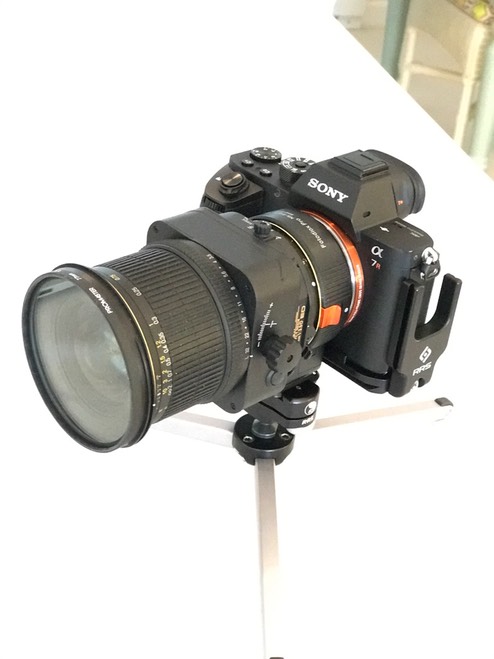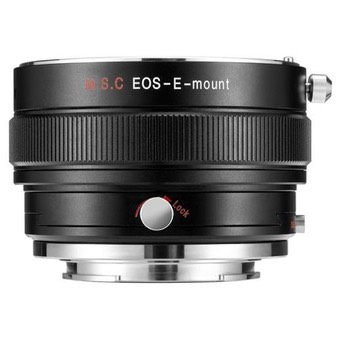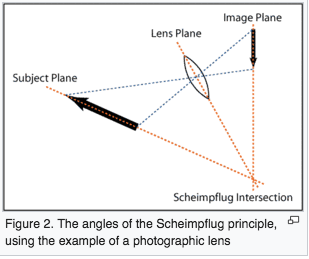I have been fascinated by the creative potential of tilt-shift lenses for sometime. There are two things that get my attention. First, is the ability, using shift, to create panaoramas which stich "perfectly". The second, is to extend DOF using tilt for lanscape (and other) photography.
I purchased a Nikon PC-E lens - PC-E Nikkor 24mm f/3.5D ED.

Specs:
MFD - .7ft (.21m)
Shift +- 11.5mm
Tilt +- 8.5mm
I have previously used this lens for panoramas as described in the section: Panoramas.
In addition, I purchase a tilt-shift adapter for my SONY A7-RII camera: Kipon T&S N/G-S/E

This is a "passive" adapter which connects any Nikon lens to the SONY FE mount and also provides tilt/shift functionality.
Since tilt-shift lenses are all manual focus, I thought it would be convenient to try to match the Nikon lens with the SONY camera since the SONY can be easily manually focussed using the focus peaking feature. Further, since it is a mirrorless camera, the image can be easily viewed using the articulated rear screen. This required an adapter from Nikon mount to the SONY mount. I used the Fotodiox electronic adapter which allows for in-camera adjustment of aperture and supports the electronic shutter mechanism on the Nikon lens.

Another alternative:
Venus Laowa Magic Shift Convertor for Nikon G lenses to Sony F mount.

I purchased this convertor and tested it with a variety of Nikon lenses, connected to the SONY A7R III. Results to follow.
Product description
Convert your Laowa 12mm f/2.8 Zero-D to a Wide Angle SHIFT lens. Just like Magic. A carefully designed and patented optical system in the adapter converts the Laowa 12mm f/2.8 Zero-D to a 17mm f/4 lens with +/- 10mm Shift capability without any vignetting. The adapter is designed to use with Nikon mount lenses and Sony Full Frame E-mount cameras. LAOWA Magic Shift Converter (MSC) Laowa Magic Shift Converter (MSC) is an adapter specially designed to convert the Laowa 12mm f/2.8 Zero-D (Canon / Nikon mount) into a 17mm f/4 +/-10mm Shift lens and use it with the Sony full frame E-mount cameras. With the MSC, you can have absolute vertical lines rather than converging lines while shooting. This is a super useful feature in architecture and interior photography.Laowa Magic Shift Converter (MSC) took advantage of the short flange distance of mirrorless cameras and incorporated a patented optics system into the converter.The patented optical system in the MSC will enlarge the image circle of the 12mm f/2.8 Zero-D from 43.2mm to 60mm in diameter and convert it a 17mm f/4 lens with +/- 10mm shift capability. The camera can be rotated in a 360 full circle, allowing a quick switch between landscape and portrait framing or to change the shift direction.
In this section I want to explore the theory behind these lenses and to look further into the effects obtained when using it in the tilt mode.
First, some theory.
Tilt-shift lenses work according to the Scheimpflug Principal [1]. This principal, and the mathermatics behind it, describes how the focus plane of a lens behaves when the lens is tilted with reference to the image (sensor) plane. Normally the focus plane is parallel to the camera lens and DOF is +/- this plane. The point of focus is detemined by the focus ring on the lens which moves the internal lens element to bring the image into focus at a specific distance from the camera. When focussed at infinity, the distance between the lens and the image sensor is equal to the focal length of the lens [2]. When the lens is tilted the focus plane also tilts and, depending on the tilt angle, can achieve DOF effects not possible with ordinary lenses.

If you want the full theory, go to reference [1]. For a more practical guide and access to a tilt "calculator", go to [3], [4], [5]
[1] https://en.wikipedia.org/wiki/Scheimpflug_principle#Proof_of_the_Scheimpflug_principle
[2] https://en.wikipedia.org/wiki/Focal_length
[3] http://www.cambridgeincolour.com/tutorials/tilt-shift-lenses2.htm
[4] https://www.onlandscape.co.uk/2011/04/tiltshift-photography-an-introduction-to-tilt/